
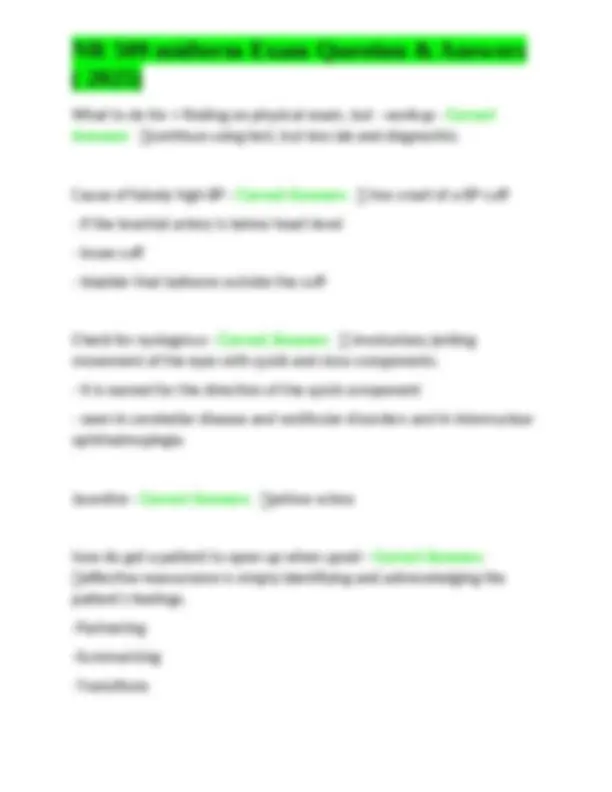
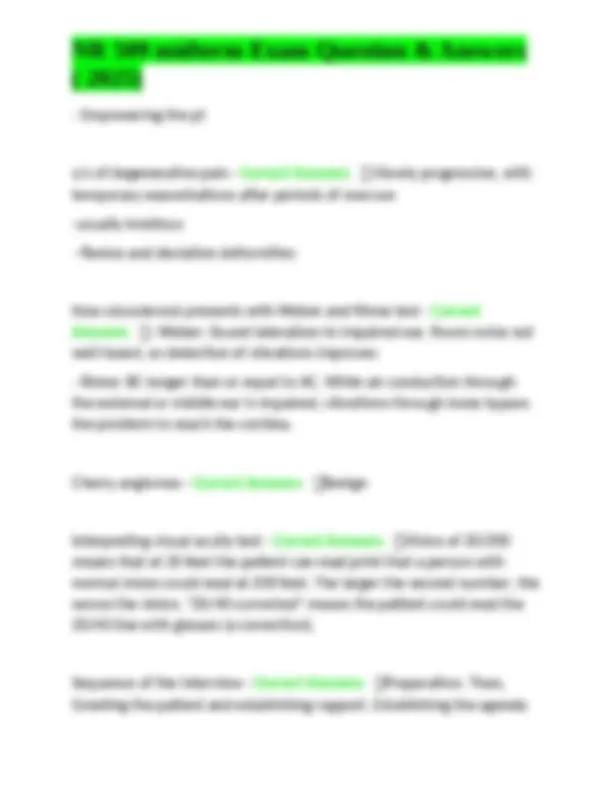
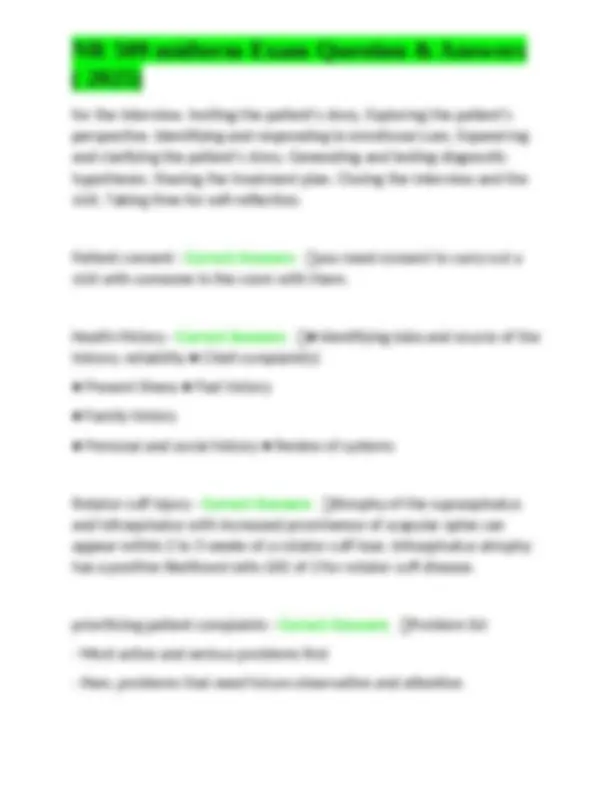
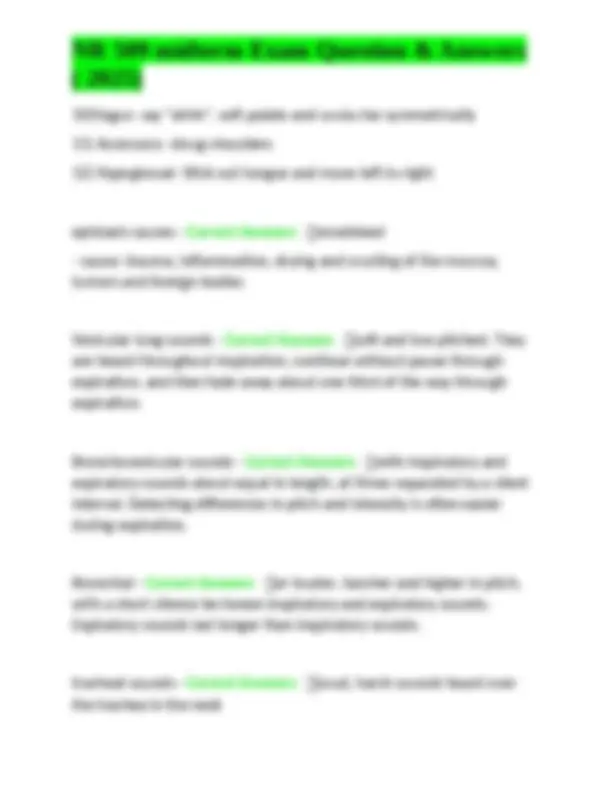
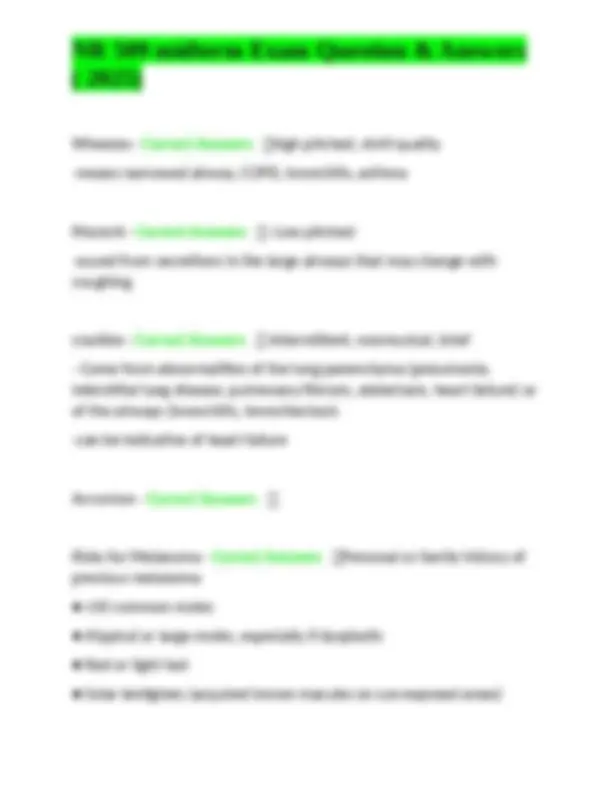
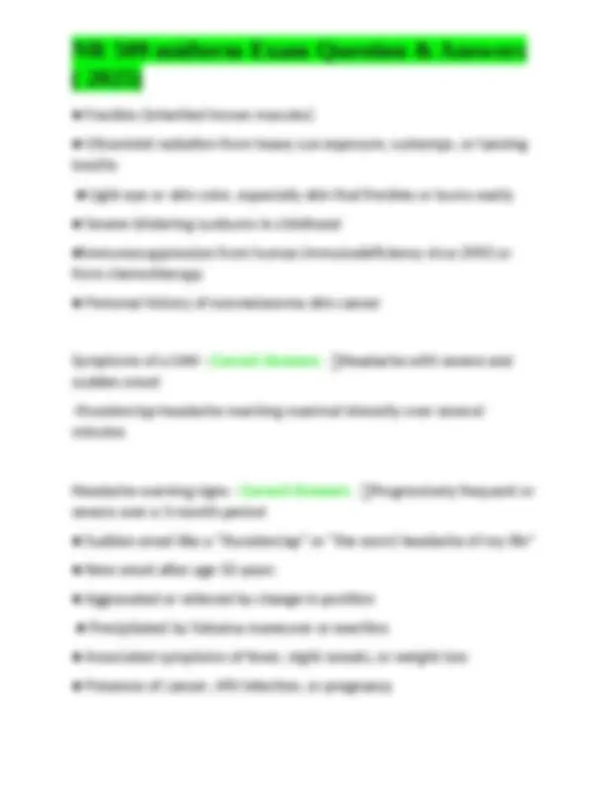
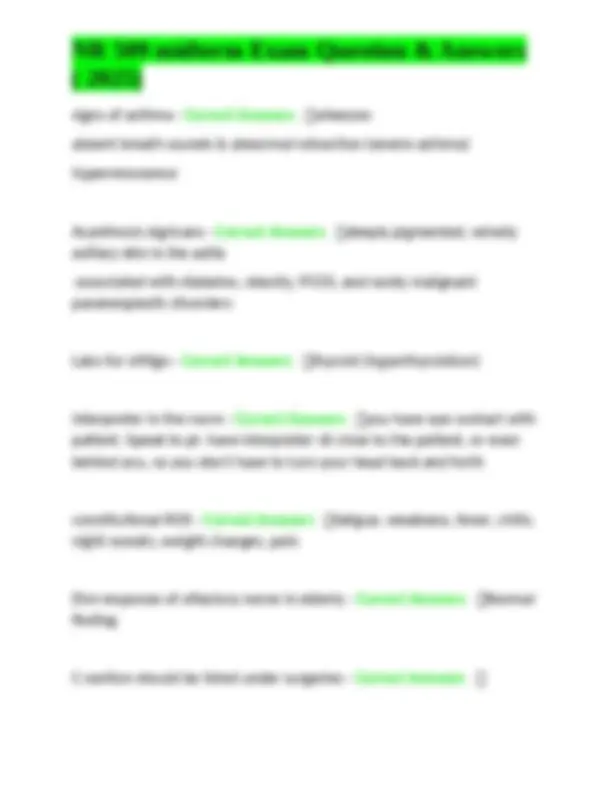
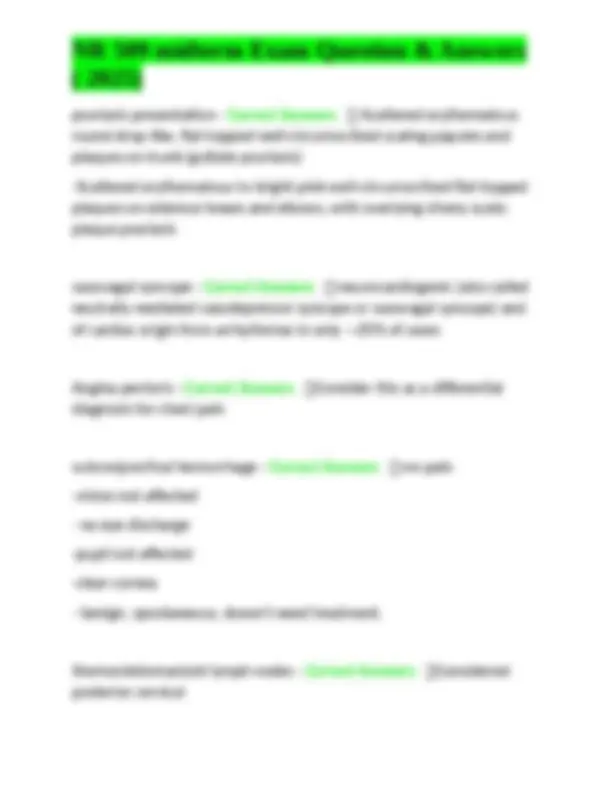
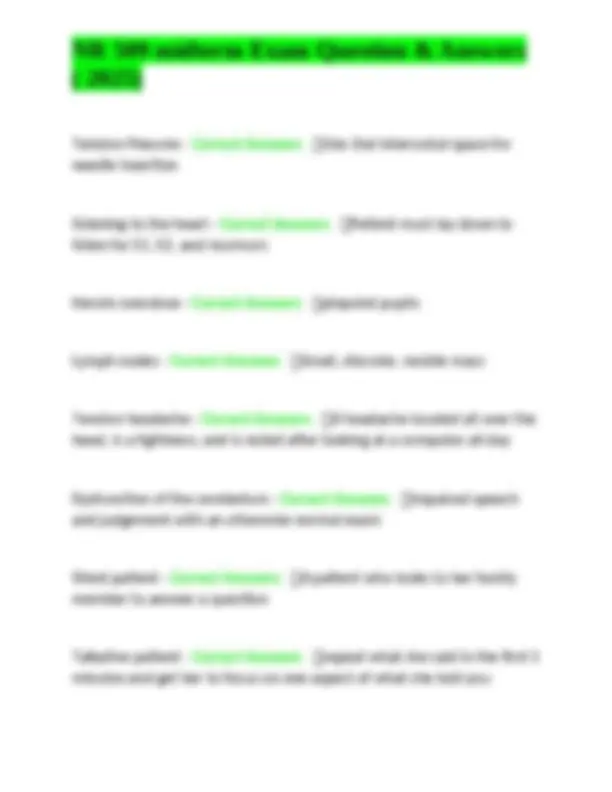


Study with the several resources on Docsity

Earn points by helping other students or get them with a premium plan


Prepare for your exams
Study with the several resources on Docsity

Earn points to download
Earn points by helping other students or get them with a premium plan
Community
Ask the community for help and clear up your study doubts
Discover the best universities in your country according to Docsity users
Free resources
Download our free guides on studying techniques, anxiety management strategies, and thesis advice from Docsity tutors
A collection of questions and answers related to the nr 509 midterm exam, covering various topics in nursing practice. It includes questions on physical examination findings, patient history, and common medical conditions. Useful for students preparing for the nr 509 midterm exam, offering insights into potential exam content and providing a framework for understanding key concepts.
Typology: Exams
1 / 16

This page cannot be seen from the preview
Don't miss anything!










Cause of saddle numbness and urinary retention - Correct Answers ✅Cauda equina syndrome Presentation of retinal detachment - Correct Answers ✅If sudden visual loss is unilateral and painless, Obtunded - Correct Answers ✅patient opens the eyes and looks at you but responds slowly and is somewhat confused. Alertness and interest in the environment are decreased. Cranial nerve for lateral gaze - Correct Answers ✅CN6: Abducens Adult Illnesses - Correct Answers ✅Medical: Illnesses such as diabetes, hypertension, hepatitis, asthma, and human immunodeficiency virus (HIV); hospitalizations; number and gender of sexual partners; and risk- taking sexual practices ■ Surgical: Dates, indications, and types of operations ■ Obstetric/Gynecologic: Obstetric history, menstrual history, methods of contraception, and sexual function ■ Psychiatric: Illness and time frame, diagnoses, hospitalizations, and treatments Present Illness - Correct Answers ✅chronologic description of the problems prompting the patient's visit, including the onset of the
problem, the setting in which it developed, its manifestations, and any treatments to date.Each problem/symptom needs: (1) location; (2) quality; (3) quantity or severity; (4) timing, including onset, duration, and frequency; (5) the setting in which it occurs; (6) factors that have aggravated -meds, allergies, tobacco use, ETOH and drug use Absence of red reflex - Correct Answers ✅an opacity of the lens (cataract) or, possibly, the vitreous (or even an artificial eye). Less commonly, a detached retina or, in children, a retinoblastoma may obscure this reflex. S/S of seasonal allergies - Correct Answers ✅Itching, watery eyes, sneezing, ear congestion, postnasal drainage Presentation of optic neuritis - Correct Answers ✅Enlarged blind spot, vision loss in 1 eye, loss of color vision, hole in center of vision, trouble seeing to the side, eye pain pityriasis rosea - Correct Answers ✅Multiple round to oval scaling violaceous plaques on abdomen and back Acromion - Correct Answers ✅tip of shoulder
for the interview. Inviting the patient's story. Exploring the patient's perspective. Identifying and responding to emotional cues. Expand-ing and clarifying the patient's story. Generating and testing diagnostic hypotheses. Sharing the treatment plan. Closing the interview and the visit. Taking time for self-reflection. Patient consent - Correct Answers ✅you need consent to carry out a visit with someone in the room with them. Health History - Correct Answers ✅● Identifying data and source of the history; reliability ● Chief complaint(s) ● Present illness ● Past history ● Family history ● Personal and social history ● Review of systems Rotator cuff injury - Correct Answers ✅Atrophy of the supraspinatus and infraspinatus with increased prominence of scapular spine can appear within 2 to 3 weeks of a rotator cuff tear; infraspinatus atrophy has a positive likelihood ratio (LR) of 2 for rotator cuff disease. prioritizing patient complaints - Correct Answers ✅Problem list
sources of joint pain - Correct Answers ✅-If age <60 years, consider repetitive strain or overuse syndromes like tendinitis or bursitis, crystalline arthritis (gout; crystalline pyrophosphate deposition disease [CPPD]) (males), rheumatoid arthritis (RA), psoriatic arthritis and reactive (Reiter) arthritis (in inflammatory bowel disease [IBD]), and infectious arthritis from gonorrhea, Lyme disease, or viral or bacterial infections.
10)Vagus- say "ahhh". soft palate and uvula rise symmetrically
● Freckles (inherited brown macules) ● Ultraviolet radiation from heavy sun exposure, sunlamps, or tanning booths ● Light eye or skin color, especially skin that freckles or burns easily ● Severe blistering sunburns in childhood ●Immunosuppression from human immunodeficiency virus (HIV) or from chemotherapy ● Personal history of nonmelanoma skin cancer Symptoms of a SAH - Correct Answers ✅Headache with severe and sudden onset -thunderclap headache reaching maximal intensity over several minutes Headache warning signs - Correct Answers ✅Progressively frequent or severe over a 3-month period ● Sudden onset like a "thunderclap" or "the worst headache of my life" ● New onset after age 50 years ● Aggravated or relieved by change in position ● Precipitated by Valsalva maneuver or exertion ● Associated symptoms of fever, night sweats, or weight loss ● Presence of cancer, HIV infection, or pregnancy
● Recent head trauma ● Change in pattern from past headaches ● Lack of a similar headache in the past ● Associated papilledema, neck stiffness, or focal neurologic deficits Making a pelvic exam more comfortable - Correct Answers ✅Obtains permission; selects chaperone Explains each step of the examination in advance Drapes the patient from mid-abdomen to knees; depresses the drape between the knees to provide eye contact with patient Avoids unexpected or sudden movements Chooses a speculum that is the correct size Warms the speculum with tap water Monitors the comfort of the examination by watching the patient's face Uses excellent but gentle technique, especially when inserting the speculum if one patient comes from another country - Correct Answers ✅You still need to be selective in who you screen for malaria Signs of increased ICP - Correct Answers ✅Papilledema ( pink, hyperemic, loss of venous pulsations, disc more visible, disc swollen with blurred margins, physiologic cup not visible)
signs of asthma - Correct Answers ✅wheezes absent breath sounds & abnormal retraction (severe asthma) hyperresonance Acanthosis nigricans - Correct Answers ✅deeply pigmented, velvety axillary skin in the axilla -associated with diabetes, obesity, PCOS, and rarely malignant paraneoplastic disorders Labs for vitiligo - Correct Answers ✅thyroid (hyperthyroidism) interpreter in the room - Correct Answers ✅you have eye contact with patient. Speak to pt. have interpreter sit close to the patient, or even behind you, so you don't have to turn your head back and forth constitutional ROS - Correct Answers ✅fatigue, weakness, fever, chills, night sweats, weight changes, pain Dim response of olfactory nerve in elderly - Correct Answers ✅Normal finding C-section should be listed under surgeries - Correct Answers ✅
psoriasis presentation - Correct Answers ✅-Scattered erythematous round drop-like, flat-topped well-circumscribed scaling papules and plaques on trunk (guttate psoriasis) -Scattered erythematous to bright pink well-circumscribed flat-topped plaques on extensor knees and elbows, with overlying silvery scale; plaque psoriasis vasovagal syncope - Correct Answers ✅-neurocardiogenic (also called neutrally mediated vasodepressor syncope or vasovagal syncope) and of cardiac origin from arrhythmias in only ∼20% of cases Angina pectoris - Correct Answers ✅Consider this as a differential diagnosis for chest pain subconjunctival hemorrhage - Correct Answers ✅-no pain -vision not affected
Glaucoma - Correct Answers ✅Increased cup-to-disc ratio Bulging discs - Correct Answers ✅Vertebral bodies of the spin associated with bulging disc are cartilaginous